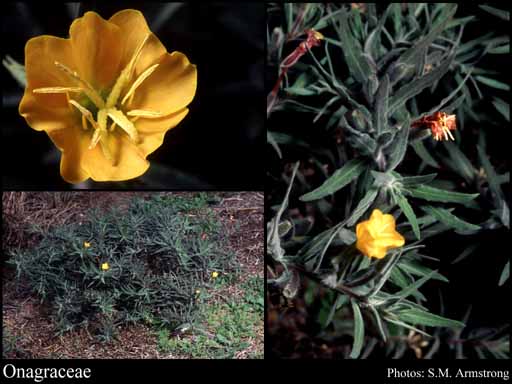- Reference
- Gen.Pl. [Jussieu] 317 (1789)
- Name Status
- Current







Scientific Description
Common name. Evening Primrose Family.
Habit and leaf form. Shrubs and herbs, or trees (rarely, to 30 m); bearing essential oils, or without essential oils. Annual, or biennial, or perennial; plants with a basal concentration of leaves, or with neither basal nor terminal concentrations of leaves. Hydrophytic, or helophytic, or mesophytic; when hydrophytic (Ludwigia), rooted. Leaves of Ludwigia emergent and floating; alternate, or opposite, or whorled; when alternate, spiral; petiolate to sessile; non-sheathing; simple; epulvinate. Leaf blades dissected, or entire; when dissected, pinnatifid; pinnately veined; cross-venulate. Leaves with stipules, or without stipules. Stipules when present, intrapetiolar; free of one another; caducous. Leaves without a persistent basal meristem. Stem anatomy. Nodes unilacunar. Secondary thickening developing from a conventional cambial ring, or anomalous; via concentric cambia, or from a single cambial ring.
Reproductive type, pollination. Fertile flowers hermaphrodite. Unisexual flowers absent. Plants hermaphrodite (usually). Anemophilous, or entomophilous.
Inflorescence and flower features. Flowers solitary, or aggregated in ‘inflorescences’; in panicles, in racemes, and in spikes. Inflorescences terminal, or axillary. Flowers small to large; regular to very irregular; (2–)4(–7) merous; cyclic; tricyclic, or tetracyclic, or pentacyclic. Free hypanthium usually present (usually elongated). Perianth with distinct calyx and corolla (usually), or sepaline (the corolla sometimes absent); 4–8(–14); 1 -whorled, or 2 -whorled; isomerous. Calyx (2–)4(–7); 1 -whorled; gamosepalous; blunt-lobed; lobes valvate. Corolla (2–)4(–7) (rarely absent); 1 -whorled; polypetalous; imbricate, or contorted; yellow, or pink, or purple. Petals clawed (often), or sessile. Corolla members often bilobed (or trilobed). Androecium 8 (often), or 8–10, or 4, or 2, or 1. Androecial members adnate (to the hypanthium), or free of the perianth (on the disk); all equal, or markedly unequal; free of one another; 2 -whorled (often), or 1 -whorled. Androecium exclusively of fertile stamens, or including staminodes. Staminodes when present, 1, or 2–4; petaloid (Lopezia), or non-petaloid. Stamens (1–)8(–10); reduced in number relative to the adjacent perianth (rarely), or isomerous with the perianth, or diplostemonous. Anthers dorsifixed; versatile; dehiscing via longitudinal slits; introrse; tetrasporangiate. Pollen shed in aggregates, or shed as single grains; with viscin strands (often), or without viscin strands; when in aggregates, in tetrads. Gynoecium 4(–7) carpelled. The pistil 2–7 celled. Carpels isomerous with the perianth. Gynoecium syncarpous; synstylovarious, or eu-syncarpous; inferior, or partly inferior. Ovary plurilocular; 4 locular (when inferior, usually — but the septa often imperfect below), or 3–7 locular (Ludwigia), or 2 locular (when half-inferior). Epigynous disk present. Gynoecium stylate. Styles 1; apical. Stigmas 1–4; wet type, or dry type; papillate, or non-papillate; Group II type, or Group III type, or Group IV type. Placentation axile, or parietal. Ovules 1–50 per locule (to ‘many’); pendulous, or ascending; non-arillate; anatropous.
Fruit and seed features. Fruit fleshy (rarely), or non-fleshy; dehiscent, or indehiscent; a capsule (usually), or a berry, or a drupe, or a nut. The drupes with separable pyrenes. Capsules loculicidal, or septicidal. Fruit 2–100 seeded (usually ‘many’). Seeds non-endospermic; conspicuously hairy, or not conspicuously hairy; with a tuft of hairs (sometimes, in Epilobium), or without a tuft of hairs. Cotyledons 2. Embryo achlorophyllous (5/5); straight. Seedling. Germination phanerocotylar.
Physiology, biochemistry. Aluminium accumulation not found. Photosynthetic pathway: C3.
Geography, cytology, number of species. World distribution: cosmopolitan, except in arid parts of Australia and Africa. X = (6-)7(-18). 640 species.
Economic uses, etc. Most genera include species cultivated as ornamentals, with Fuchsia contributing many. Fuchsia berries are edible and good.